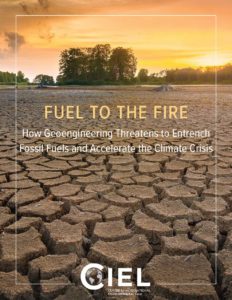
Fuel to the Fire: How Geoengineering Threatens to Entrench Fossil Fuels and Accelerate the Climate Crisis investigates the early, ongoing, and often surprising role of the fossil fuel industry in developing, patenting, and promoting key geoengineering technologies. It examines how the most heavily promoted strategies for carbon dioxide removal and solar radiation modification depend on the continued production and combustion of carbon-intensive fuels for their viability. It analyzes how the hypothetical promise of future geoengineering is already being used by major fossil fuel producers to justify the continued production and use of oil, gas, and coal for decades to come. It exposes the stark contrast between the emerging narrative that geoengineering is a morally necessary adjunct to dramatic climate action, and the commercial arguments of key proponents that geoengineering is simply a way of avoiding or reducing the need for true systemic change, even as converging science and technologies demonstrate that shift is both urgently needed and increasingly feasible. Finally, it highlights the growing incoherence of advocating for reliance on speculative and risky geoengineering technologies in the face of mounting evidence that addressing the climate crisis is less about technology than about political will.
Table of contents:
Executive Summary
Introduction: Postcards from the Edge of a Climate Breakdown
Part 1: The Scientific Basis and Moral Imperative for Urgent Climate Action
Part 2: Geoengineering: Carbon Dioxide Removal, Solar Radiation Management, and Beyond
– “…with Carbon Capture & Storage”: Why CCS is Vital to the Geoengineering Debate Geoengineering May Entrench Fossil Fuel Interests
Part 3: Asphalt Fields and Black Carbon Skies: A Brief History of Fossil Fuels and Weather Modification
– Early Oil Industry Interest in Weather Modification
– The Importance of Acknowledging this Early Fossil Fuel Interest
Part 4: Carbon Dioxide Removal and Negative Emissions: The Pervasive Role of Carbon Capture, Use, and Storage
– Carbon In, Carbon Out: Captured Carbon and Enhanced Oil Recovery
– How Carbon Dioxide Removal will “Save” the Coal Industry
– Industry’s Pervasive Role in CCS Resarch and Policy
– Carbon Dioxide Removal and Oil’s Plans for the Next Petroleum Century
– Direct Air Capture: Turning Renewable Energy into New Carbon Emissions
– Enhanced Weathering and Carbon Mineralization
– Ocean Iron Fertilization and Alkalinization
Part 5: Bioenergy, BECCS, and the Real Cost of Carbon Accounting
– Fossil Industry Investment in Biofuels and BECCS
Part 6: Paved with Good Intentions: The Danger and Distraction of Solar Radiation Modification
– Burning Fossil Fuels Proved SRM is Possible—and Demonstrated Its Risks
– Early Industry Interest in SRM and Stratospheric Aerosol Injection Counting—and Not
– Counting—the Costs of SRM
– This is a Test. But is it Only a Test?
– Industry Influence in SRM
– The New Climate Denial
Part 7: We Must and Can Stay Below 1.5oC without Geoengineering
– Renewables are Eliminating the Rationale for Coal and Gas in Energy Generation
– The Pace of Renewable Deployments Consistently Exceeds Official Forecasts
– The Energy Revolution in the Transport Sector Extends Far Beyond Cars
– Low-Tech, Win-Win Approaches to Climate Mitigation and Carbon Removal are Ready to Be Scaled Up 59
Part 8: Conclusions
Endnotes
